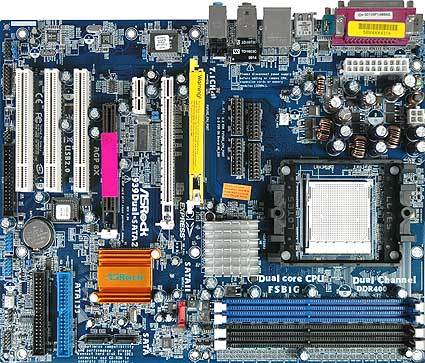ASRock 939Dual-SATA2: With AGP and PCIe
939Dual-SATA2 In Detail

Board-Revision: 1.04
BIOS-Version: 1.1
The fact that ASRock was able to nicely resolve the space problem is somewhat surprising in view of the numerous components that the board provides. In addition to the slots for x16 PCI Express and AGP, ASRock offers a x1 PCIe slot for future expansion cards, as well as three PCI slots for normal 32-bit cards. In addition, located in the middle of the board is an extra AGP-like slot that can hold a processor expansion card. This is intended to let the board implement future AMD processors without any major effort. In order to manage that, the phalanx of jumpers right next to the slot has to be activated; we could not test the slot, however, due to the lack of an expansion card. According to the user manual, there will be a model available for future AMD processors on Socket M2.
Unlike the Intel chipsets for the Pentium family, the ULi M1695 - or rather, its Southbridge - still features two UltraATA/133 channels, so not-so-new hard disks and optical drives can still be connected. The chipset actually only offers two serial ATA I ports; ASRock also implanted a small controller as a supplement which enables another port for SATA II. Thus, at least for a hard disk, command queuing and transfers up to 300 MB/s are possible - even if the latter scarcely makes a difference in practice.
The board is virtually inundated with info stickers: "Please do not use 3.3V AGP cards," "Future CPU port available," "SATA hot plugging not supported due to chipset limitations", etc. In the process, the manufacturer chaotically mixed in the really important pointers with mere references to features. Even obvious facts like USB 2.0, AGP 8X, SATA II and catch phrases like "Dual Core CPU" and "Dual Channel DDR400" are to be found on the board. Neither is the choice of positioning straightforward. For example, while the SATA, SATA II and AGP 8X labels are right next to their respective connectors, the "USB 2.0" is not. While it won't bother professionals, newcomers are likely to find the jumble of "helpful" pointers confusing.
Thanks to Socket 939, all current AMD processors up to the Dual Core Athlon 64 X2 are supported. A four-phase voltage converter ensures sufficient energy supply. ASRock's sound system is based on a Realtek PHY and supports 7.1 sound.
Four USB 2.0 ports are located in the back panel and four more can be activated if needed. A corresponding adapter cable has to be bought separately, however, since the package contents are meager, basically the minimum typical of budget boards. And unfortunately, the network chip is not gigabit-capable.
Get Tom's Hardware's best news and in-depth reviews, straight to your inbox.
It's worth noting that during the tests we measured a high temperature on the ULi Northbridge M1695: we saw values of about 131°F (55°C) in the bottom part of the heatsink. In contrast, the chip on ULi's reference board was significantly cooler.
The performance capability of the ASRock board is a bit less than what we would expect judging by the reference board from the chipset manufacturer. For comparison we brought in a Fatal1ty A8N from Abit, which can be considered a very solid and flexible board using NVIDIA's nForce4 Ultra.
Current page: 939Dual-SATA2 In Detail
Prev Page Everything Dual: 939Dual-SATA2 From ASRock Next Page 939Dual-SATA2 In Detail, Continued
Patrick Schmid was the editor-in-chief for Tom's Hardware from 2005 to 2006. He wrote numerous articles on a wide range of hardware topics, including storage, CPUs, and system builds.